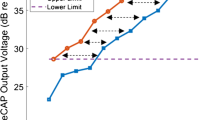Abstract
Little work has been reported which characterises the electrical behaviour of electrode materials used for extracochlear stimulation. Electrode properties were investigated to optimise preparation methods and facilitate the design of electrode driving circuitry. Electrode preparation techniques were developed in vitro, using a combination of electrochemical measurements and scanning electron microscopy. Electrochemical etching gave the lowest observed impedances. Four subjects were each temporarily implanted with two active extracochlear electrodes, one of pure platinum and another of electrochemically etched platinums/10 per cent iridium alloy impedance measurements were taken over a ten-day implantation period and were interpreted by a simple electrical model. Constant-current stimulation was perceptually more effective than voltage-controlled excitation for the same energy input. Stimulation dynamic ranges were measured and used to estimate design limits for practical stimulators. The effect of changing electrode diameters was studied in vitro and was related to the same model. The best in vitro analogue of the in vivo environment was found to be dilute isotonic saline.
Similar content being viewed by others
References
Brummer, S. B. andTurner, M. J. (1977) Electro-chemical considerations for safe electrical stimulation of the nervous system with platinum electrodes.IEEE Trans.,BME-24, 59–63.
de Boer, R. W. andvan Oosterom, A. (1978) Electrical properties of platinum electrodes: impedance measurements and time-domain analysis.Med. & Biol. Eng. & Comput.,16, 1–10.
Donaldson, N. de N. andDonaldson, P. E. K. (1986a) When are actively balanced (‘Lilly’) stimulating pulses necessary in a neurological prosthesis?Med. & Biol. Eng. & Comput.,24, 41–56.
Donaldson, N. de N. andDonaldson, P. E. K. (1986b) Performance of platinum stimulating electrodes mapped on the limit voltage plane. Part 2 Corrosionin vitro.,24, 431–438.
Fricke, H. (1932) The theory of electrolyte polarization.Phil. Mag.,14, 310–318.
Jaron, D., Briller, S. A., Schwan, H. P. andGefelowitz, D. B. (1969) Non-linearity of cardiac pacemaker electrodes.IEEE Trans.,BME-16, 132–138.
Onaral, B. andSchwan, H. P. (1983) Linear and nonlinear properties of platinum electrode polarisation. II: time domain analysis.Med. & Biol. Eng. & Comput.,21, 210–216.
Parkins, C. W. (1983) Cochlear implant: a sensory prosthesis frontier.Eng. in Med. & Biol., June 1983, 18–27.
Pfingst, B. E. andSutton, D. (1983) Relation of cochlear implant function to histopathology in monkeys. InCochlear prostheses.Parkins, C. W. andAnderson, S. W. (Eds.),Ann. NY Acad. Sci. 405, 224–239.
Schwan, H. P. (1968) Electrode polarization impedance and measurements in biological materials.Ann. NY Acad. Sci.,148, 191–209.
Spelman, F. A., Clopton, B. M. andPfingst, B. E. (1982) Tissue impedance and current flow in the implanted ear.Ann. Otol. Rhinol. Laryngol., Suppl. 91, (3), 3–8.
Walliker, J. R., Douek, E. E., Frampton, S., Abberton, E., Fourcin, A. J., Howard, D. M., Nevard, S., Rosen, S. andMoore, B. C. J. (1985) Physical and surgical aspects of external single channel electrical stimulation of the totally deaf. InCochlear implants.Schindler, R. A. andMerzenich, M. M. (Eds.), Raven Press, New York, 143–155.
Author information
Authors and Affiliations
Rights and permissions
About this article
Cite this article
Ison, K.T., Walliker, J.R. Platinum and platinum/iridium electrode properties when used for extracochlear electrical stimulation of the totally deaf. Med. Biol. Eng. Comput. 25, 403–413 (1987). https://doi.org/10.1007/BF02443361
Received:
Accepted:
Issue Date:
DOI: https://doi.org/10.1007/BF02443361




